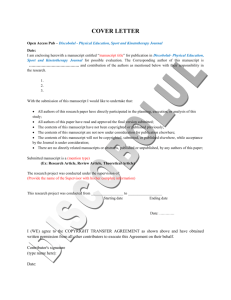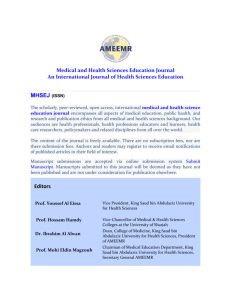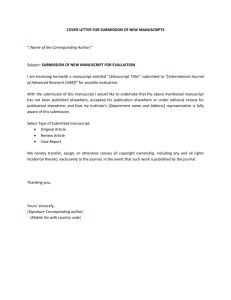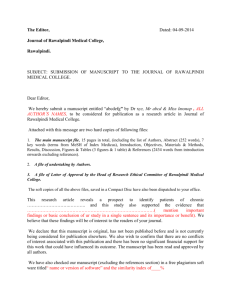Manuscript Template
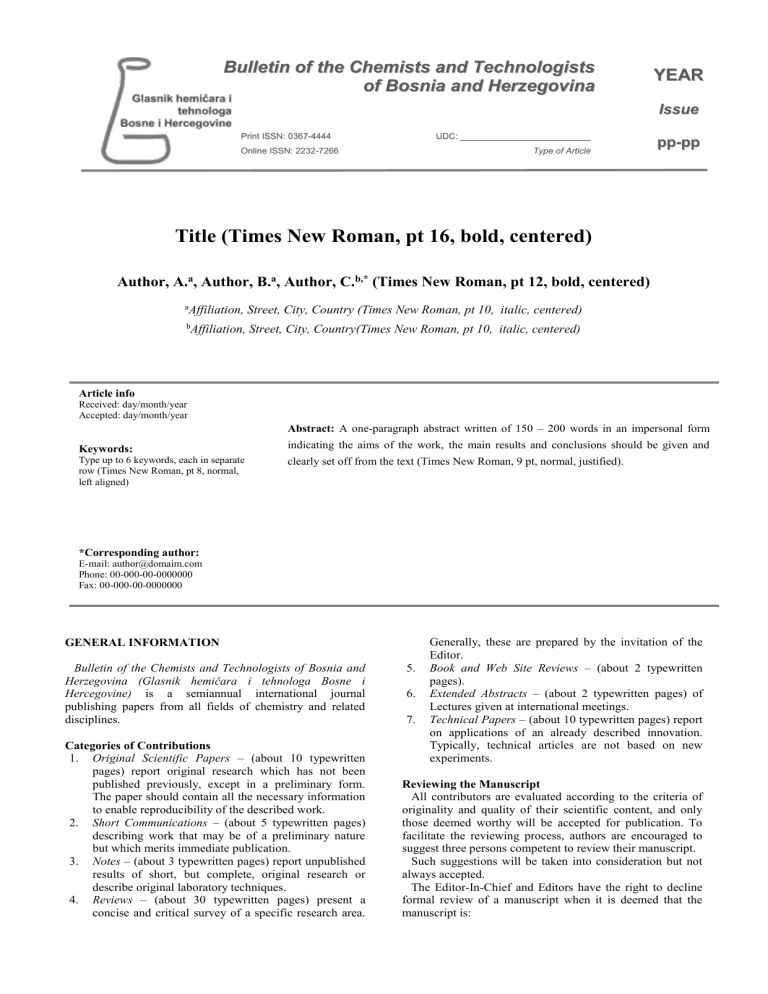
B u l l l l e t t i i n o f f t t h e C h e m i i s t t s a n d T e c h n o l l o g i i s t t s o f f B o s n i i a a n d H e r r z e g o v i i n a
P r r i i n t t I I S S N : : 0 3 6 7 4 4 4 4
O n l l i n e I S S N : 2 2 3 2 7 2 6 6
U D C : : _ _ _ _ _ _ _ _ _ _ _ _ _ _ _ _ _ _ _ _ _ _ _ _ _ _
T y p e o f f A r r t i c l e
Y E A R
I I s s u e p p p p
Title (Times New Roman, pt 16, bold, centered)
Author, A.
a
, Author, B.
a
, Author, C.
b,*
(Times New Roman, pt 12, bold, centered)
a Affiliation, Street, City, Country (Times New Roman, pt 10, italic, centered) b Affiliation, Street, City, Country(Times New Roman, pt 10, italic, centered)
Article info
Received: day/month/year
Accepted: day/month/year
Keywords:
Type up to 6 keywords, each in separate row (Times New Roman, pt 8, normal, left aligned)
*Corresponding author:
E-mail: author@domaim.com
Phone: 00-000-00-0000000
Fax: 00-000-00-0000000
GENERAL INFORMATION
Abstract: A one-paragraph abstract written of 150 – 200 words in an impersonal form indicating the aims of the work, the main results and conclusions should be given and clearly set off from the text (Times New Roman, 9 pt, normal, justified).
Bulletin of the Chemists and Technologists of Bosnia and
Herzegovina (Glasnik hemičara i tehnologa Bosne i
Hercegovine) is a semiannual international journal publishing papers from all fields of chemistry and related disciplines.
Categories of Contributions
1.
Original Scientific Papers – (about 10 typewritten pages) report original research which has not been published previously, except in a preliminary form.
The paper should contain all the necessary information to enable reproducibility of the described work.
2.
Short Communications – (about 5 typewritten pages) describing work that may be of a preliminary nature but which merits immediate publication.
3.
Notes – (about 3 typewritten pages) report unpublished results of short, but complete, original research or describe original laboratory techniques.
4.
Reviews – (about 30 typewritten pages) present a concise and critical survey of a specific research area.
Generally, these are prepared by the invitation of the
Editor.
5.
Book and Web Site Reviews – (about 2 typewritten pages).
6.
Extended Abstracts – (about 2 typewritten pages) of
Lectures given at international meetings.
7.
Technical Papers
– (about 10 typewritten pages) report on applications of an already described innovation.
Typically, technical articles are not based on new experiments.
Reviewing the Manuscript
All contributors are evaluated according to the criteria of originality and quality of their scientific content, and only those deemed worthy will be accepted for publication. To facilitate the reviewing process, authors are encouraged to suggest three persons competent to review their manuscript.
Such suggestions will be taken into consideration but not always accepted.
The Editor-In-Chief and Editors have the right to decline formal review of a manuscript when it is deemed that the manuscript is:
2 Author et al .
1.
on a topic outside the scope of the Journal;
2.
lacking technical merit;
3.
of insufficient novelty for a wide international readership;
4.
fragmentary and providing marginally incremental results; or
5.
is poorly written.
Proofs
When a manuscript is ready for printing, the corresponding author will receive a PDF-formatted manuscript for proof reading, which should be returned to the journal within one week. Failure to do so will be taken as the authors are in agreement with any alteration which may have occurred during the preparation of the manuscript.
Copyright
Subscribers may reproduce tables of contents or prepare lists of articles including abstracts for internal circulation within their institutions. Permission of the Publisher is required for resale or distribution outside the institution and for all other derivative works, including compilations and translations.
Professional Ethics and Publication Policy
The journal expects the Editors, Referees and authors to adhere to the well-known standards of professional ethics.
Authors are responsible for the factual accuracy of their contributions. Submission of the paper commits the author not to submit the same material elsewhere. Referees should act promptly. If certain circumstances preclude prompt attention to the manuscript at the time it is received, the nonreceived manuscript should be returned immediately to the
Editor or the Referee should contact the Editor for possible delay of the report submission date. The Editor accepts full responsibility for his decisions on the manuscripts.
PREPARATION AND SUBMISSION OF
MANUSCRIPT
Cover Letter
Manuscripts must be accompanied by a cover letter in which the type of the submitted manuscript. It should contain:
1.
full name(s) of the author(s),
2.
mailing address (address, phone and fax numbers, email) of the author to whom correspondence should be addressed,
3.
title of the paper (concise, without any abbreviations),
4.
type of contribution,
5.
a statement that the article is original and is currently not under consideration by any other journal or any other medium, including preprints, electronic journals and computer databases in the public domain, and
6.
the names, full affiliation (department, institution, city and country), and
7.
e-mail addresses of three potential Referees.
Contributors from Bosnia and Herzegovina should provide the name and full affiliation of at least one Referee from abroad.
Authors are fully encouraged to use Cover Letter
Template.
Manuscript preparation
The submitted articles must be prepared with Word for
Windows. Manuscripts should be typed in English (either standard British or American English, but consistent throughout) with 1.5 spacing (12 points Times New Roman;
Greek letters in the character font Symbol) in A4 format leaving 2.5 cm for margins. Authors are fully encouraged to use Manuscript Template .
Table 1 : Please use this paragraph to type the the heading for a table.
Compds IC
50
, nM Compds IC
50
, nM a b
1 24.00 6 1.7
2
3
4
0.87
0.59
2.8
7
8
9
5 0.91
Please use this paragraph to type the table footer(s).
3.0
2.4
2.1
All contributions should be written in a style that addresses a wider audience than papers in more specialized journals.
Manuscripts with grammar or vocabulary deficiencies are disadvantaged during the scientific review process and, even if accepted, may be returned to the author to be rewritten in idiomatic English. The authors are requested to seek the assistance of competent English language expert, if necessary, to ensure their English is of a reasonable standard.
The journal maintains its policy and takes the liberty of correcting the English of manuscripts scientifically accepted for publication.
Tables and figures and/or schemes should not be embedded in the manuscript but their position in the text indicated. In electronic version (Word.doc document) tables and figures and/or schemes should follow the text, each on a separate page. Please number all pages of the manuscript including separate lists of references, tables and figures with their captions.
IUPAC and International Union of Biochemistry and
Molecular Biology recommendations for the naming of compounds should be followed.
SI units, or other permissible units, should be employed.
The designation of physical quantities should be in Times
New Roman font. In text, graphs, and tables, brackets should be used to separate the designation of a physical quantity from the unit. Please do not use the axes of graphs for additional explanations; these should be mentioned in the figure captions and/or the manuscript (example: “pressure at the inlet of the system, kPa” should be avoided).
Percents and per mills , although not being units in the same sense as the units of dimensioned quantities, can be treated as such. Unit symbols should never be modified (for instance: w/w %, vol.%, mol.% ) but the quantity measured has to be named, e.g. mass fraction, w =95 %; amount (mole) fraction, x =20 %.
Latin words, as well as the names of species, should be in italic , as for example: i.e., e.g., in vivo, ibid, Artemisia annua
L., etc . The branching of organic compound should also be indicated in italic , for example, n -butanol, tert -butanol, etc .
Decimal numbers must have decimal points and not commas in the text (except in the Bosnian/Croatian/Serbian abstract), tables and axis labels in graphical presentations of results. Thousands are separated, if at all, by a comma and not a point.
Bulletin of the Chemists and Technologists of Bosnia and Herzegovina Year, Issue , pp-pp
3
Structure of the Manuscript
The manuscript must contain, each on a separate page, the title page, abstract in English, (abstract in
Bosnian/Croatian/Serbian), graphical abstract (optional), main text, list of references, tables (each table separately), illustrations (each separately), and legends to illustrations
(all on the same page).
1.
Title page must contain: the title of the paper (bold letters), full name(s) of the author(s), full mailing addresses of all authors (italic), keywords (up to 6), the phone and fax numbers and the e-mail address of the corresponding author.
2.
A one-paragraph abstract written of 150–200 words in an impersonal form indicating the aims of the work, the main results and conclusions should be given and clearly set off from the text. Domestic authors should also submit, on a separate page, a Summary/Sažetak.
For authors outside Bosnia and Herzegovina, the
Editorial Board will provide a Bosnian/Croatian/Serbian translation of their English abstract.
3.
Authors are encouraged to submit a graphical abstract that describes the subject matter of the paper. It should contain the title of the paper, full name(s) of the author(s), and graphic that should be no larger than 11 cm wide by 5 cm tall. Authors are fully encouraged to use Graphical Abstract Template.
4.
Main text should have the following form:
Introduction should include the aim of the research and a concise description of background information and related studies directly connected to the paper.
Experimental section should give the purity and source of all employed materials, as well as details of the instruments used. The employed methods should be described in sufficient detail to enable experienced persons to repeat them. Standard procedures should be referenced and only modifications described in detail.
Results and Discussion should include concisely presented results and their significance discussed and compared to relevant literature data. The results and discussion may be combined or kept separate.
The inclusion of a Conclusion section, which briefly summarizes the principal conclusions, is highly recommended.
Acknowledgement (optional).
Please ensure that every reference cited in the text is also present in the reference list (and vice versa ).
Unpublished results and personal communications are not recommended in the reference list, but may be mentioned in the text. If these references are included in the reference list they should follow the standard reference style of the journal and should include a substitution of the publication date with either
"Unpublished results" or "Personal communication"
Citation of a reference as "in press" implies that the item has been accepted for publication. As a minimum, the full URL should be given and the date when the reference was last accessed. Any further information, if known (DOI, author names, dates, reference to a source publication, etc.), should also be given. No more than 30 references should be cited in your manuscript.
In the text refer to the author's name (without initials) and year of publication (e.g. "Steventon, Donald and Gladden
(1994) studied the effects..." or "...similar to values reported by others (Anderson, Douglas, Morrison, et al.
, 1990)...").
Type the names of the first three authors at first citation. At subsequent citations use first author et al.
The list of references should be arranged alphabetically by authors' names and should be as full as possible, listing all authors, the full title of articles and journals, publisher and year.
Examples of reference style : a) Reference to a journal publication:
Warren, J. J., Tronic, T. A., Mayer, J. M. (2010).
Termochemistry of proton-coupled electron transfer reagents and its implications. Chemical Reviews , 110
(12) , 6961-7001. b) Reference to a book:
Corey, E. J., Kurti, L. (2010). Enantioselective chemical synthesis . (1 st Ed.) Direct Book Publishing, LLC. c) Reference to a chapter in an edited book:
Moody, J. R., Beck II, C. M. (1997). Sample preparation in analytical chemistry. In Setlle, F. A. (Ed.), Handbook of instrumental techniques for analytical chemistry . (p.p.
55-72). Prentice Hall. d) Reference to a proceeding:
Seliskar, C. J., Heineman, W.R., Shi, Y., Slaterbeck, A.F.,
Aryal, S., Ridgway, T.H., Nevin, J.H. (1997). New spectroelectrochemical sensor , in Proceedings of 37 th
Conference of Analytical Chemistry in Energy and
Technology, Gatlinburg, Tenesee, USA, p.p. 8-11. e) Patents:
Healey, P.J., Wright, S.M., Viltro, L.J., (2004).
Method and apparatus for the selection of oral care chemistry , The
Procter & Gamble Company Intellectual Property
Division, (No.US 2004/0018475 A1). f) Chemical Abstracts:
Habeger, C. F., Linhart, R. V., Adair, J. H. (1995). Adhesion to model surfaces in a flow through system. Chemical
Abstracts, CA 124:25135. g) Standards:
ISO 4790:1992. (2008). Glass-to-glass sealings -
Determination of stresses . h) Websites:
Chemical Abstract Service, www.cas.org, (18/12/2010).
Tables are part of the text but must be given on separate pages, together with their captions. The tables should be numbered consequently in Latin numbers. Quantities should be separated from units by brackets. Footnotes to tables, in size 10 font, are to be indicated consequently
(line-by-line) in superscript letters. Tables should be prepared with the aid of the Word table function, without vertical lines. Table columns must not be formatted using multiple spaces. Table rows must not be formatted using
4 Author et al .
Insert wide figure here.
Figure 1 : Please use this paragraph to type the legend(s) for your scheme(s) or figure(s), as well as the heading for a table and the table footer(s).
Figures and/or Schemes (in high resolution) should follow the captions, each on a separate page of the manuscript. High resolution illustrations in TIF or
EPS format (JPG format is acceptable for colour and greyscale photos, only) must be uploaded as a separate archived (.zip or .rar) file.
Figures and/or Schemes should be prepared according to the artwork instructions.
Mathematical and chemical equations must be numbered, Arabic numbers, consecutively in parenthesis at the end of the line. All equations should be embedded in the text except when they contain graphical elements (tables, figures, schemes and formulae). Complex equations (fractions, inegrals, matrix…) should be prepared with the aid of the Word
Equation editor.
Insert figure here.
Figure 2 : Please use this paragraph to type the legend(s) for your scheme(s) or figure(s), as well as the heading for a table and the table footer(s).
Artwork Instructions
Journal accepts only TIF or EPS formats, as well as JPEG format (only for colour and greyscale photographs) for electronic artwork and graphic files. MS files (Word,
PowerPoint, Excel, Visio) are NOT acceptable. Generally, scanned instrument data sheets should be avoided. Authors are responsible for the quality of their submitted artwork.
Image quality: keep figures as simple as possible for clarity - avoid unnecessary complexity, colouring and excessive detail. Images should be of sufficient quality for the printed version, i.e. 300 dpi minimum.
Image size: illustrations should be submitted at its final size (8 cm for single column width or 17 cm for double column width) so that neither reduction nor enlargement is required.
Photographs: please provide either high quality digital images (250 dpi resolution) or original prints. Computer print-outs or photocopies will not reproduce well enough for publication. Colour photographs rarely reproduce satisfactorily in black and white.
The facility exist for color reproduction, however the inclusion of color photographs in a paper must be agreed with Editor in advance.
Reporting analytical and spectral data
The following is the recommended style for analytical and spectral data presentation:
1.
Melting and boiling points : mp 163–165°C (lit. 166°C) mp 180°C dec. bp 98°C
Abbreviations: mp, melting point; bp, boiling point; lit., literature value; dec, decomposition.
2.
Specific Rotation :
[a] 23
D
–222 ( c 0.35, MeOH).
Abbreviations: a, specific rotation; D, the sodium D line or wavelength of light used for determination; the superscript number, temperature (°C) at which the determination was made; In parentheses: c stands for concentration; the number following c is the concentration in grams per 100 mL; followed by the solvent name or formula.
3.
NMR Spectroscopy :
1 H NMR (500 MHz, DMSOd
6
) d 0.85 (s, 3H, CH
3
),
1.28–1.65 (m, 8H, 4´CH
2
), 4.36–4.55 (m, 2H, H-1 and
H-2), 7.41 (d, J 8.2 Hz, 1H, ArH), 7.76 (dd, J 6.0, 8.2
Hz, 1H, H-1'), 8.09 (br s, 1H, NH).
13 C NMR (125 MHz, CDCl
3
) d 12.0, 14.4, 23.7, 26.0,
30.2, 32.5, 40.6 (C-3), 47.4 (C-2'), 79.9, 82.1, 120.0
(C-7), 123.7 (C-5), 126.2 (C-4).
Abbreviations: d, chemical shift in parts per million
(ppm) downfield from the standard; J , coupling constant in hertz; multiplicities s, singlet; d, doublet; t, triplet; q, quartet; and br, broadened. Detailed peak assignments should not be made unless these are supported by definitive experiments such as isotopic labelling, DEPT, or two-dimensional NMR experiments.
Bulletin of the Chemists and Technologists of Bosnia and Herzegovina Year, Issue , pp-pp
5
4.
IR Spectroscopy :
IR (KBr) n 3236, 2957, 2924, 1666, 1528, 1348, 1097,
743 cm
–1
.
Abbreviation: n, wavenumber of maximum absorption peaks in reciprocal centimetres.
5.
Mass Spectrometry :
MS m/z (relative intensity): 305 (M + H, 100), 128 (25).
HRMS–FAB ( m/z ): [M+H] + calcd for C
21
H
38
N
4
O
6
,
442.2791; found, 442.2782.
Abbreviations: m/z , mass-to-charge ratio; M, molecular weight of the molecule itself; M + , molecular ion;
HRMS, high-resolution mass spectrometry; FAB, fast atom bombardment.
6.
UV–Visible Spectroscopy :
UV (CH
3
OH) l max
(log e) 220 (3.10), 425 nm (3.26).
Abbreviations: l max
, wavelength of maximum absorption in nanometres; e, extinction coefficient.
7.
Quantitative analysis :
Anal. calcd for C
17
H
24
N
2
O
3
: C 67.08, H 7.95, N 9.20.
Found: C 66.82, H 7.83, N 9.16. (All values are given in percentages.)
8.
Enzymes and catalytic proteins relevant data :
Papers reporting enzymes and catalytic proteins relevant data should include the identity of the enzymes/proteins, preparation and criteria of purity, assay conditions, methodology, activity, and any other information relevant to judging the reproducibility of the results * .
For more details check Beilstein Institute/STRENDA
(standards for reporting enzymology data) commission
Web site (http://www.strenda.org/documents.html).
Submission Checklist
The following list will be useful during the final checking of an article prior to sending it to the journal for review:
E-mail address for corresponding author,
Full postal address,
Telephone and fax numbers,
All figure captions,
All tables (including title, description, footnotes),
Manuscript has been "spellchecked" and
"grammar-checked",
References are in the correct format for the journal,
All references mentioned in the Reference list are cited in the text, and vice versa .
Submissions
Submissions should be directed to the Editor by e-mail: glasnik@pmf.unsa.ba
, or glasnikhtbh@gmail.com
. All manuscripts will be acknowledged on receipt (by e-mail) and given a reference number, which should be quoted in all subsequent correspondence.
_____________________
*For all other data presentation not mentioned above please contact
Editor for instructions.
Summary/Sažetak
A one-paragraph
Summary/Sažetak
written of 150–200 words in an impersonal form indicating the aims of the work, the main results and conclusions should be given and clearly set off from the text. For authors outside Bosnia and Herzegovina, the Editorial Board will provide a Bosnian/Croatian/Serbian translation of their English abstract.

